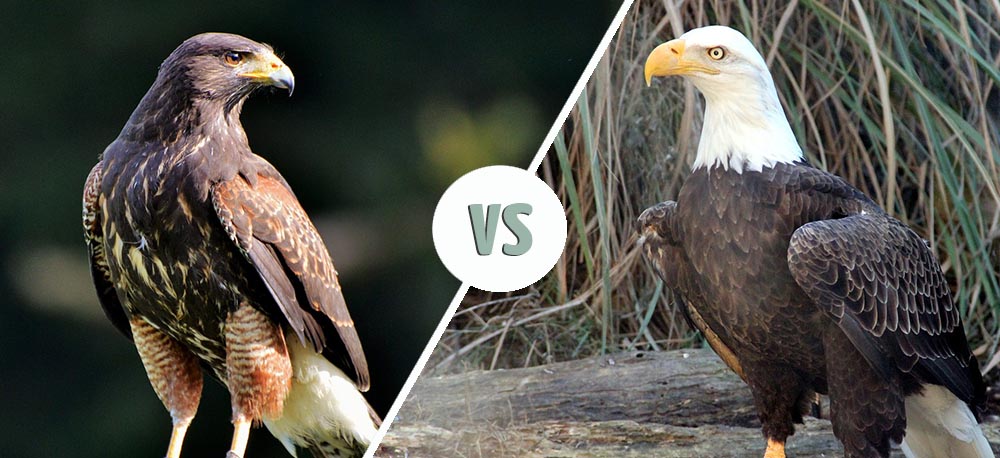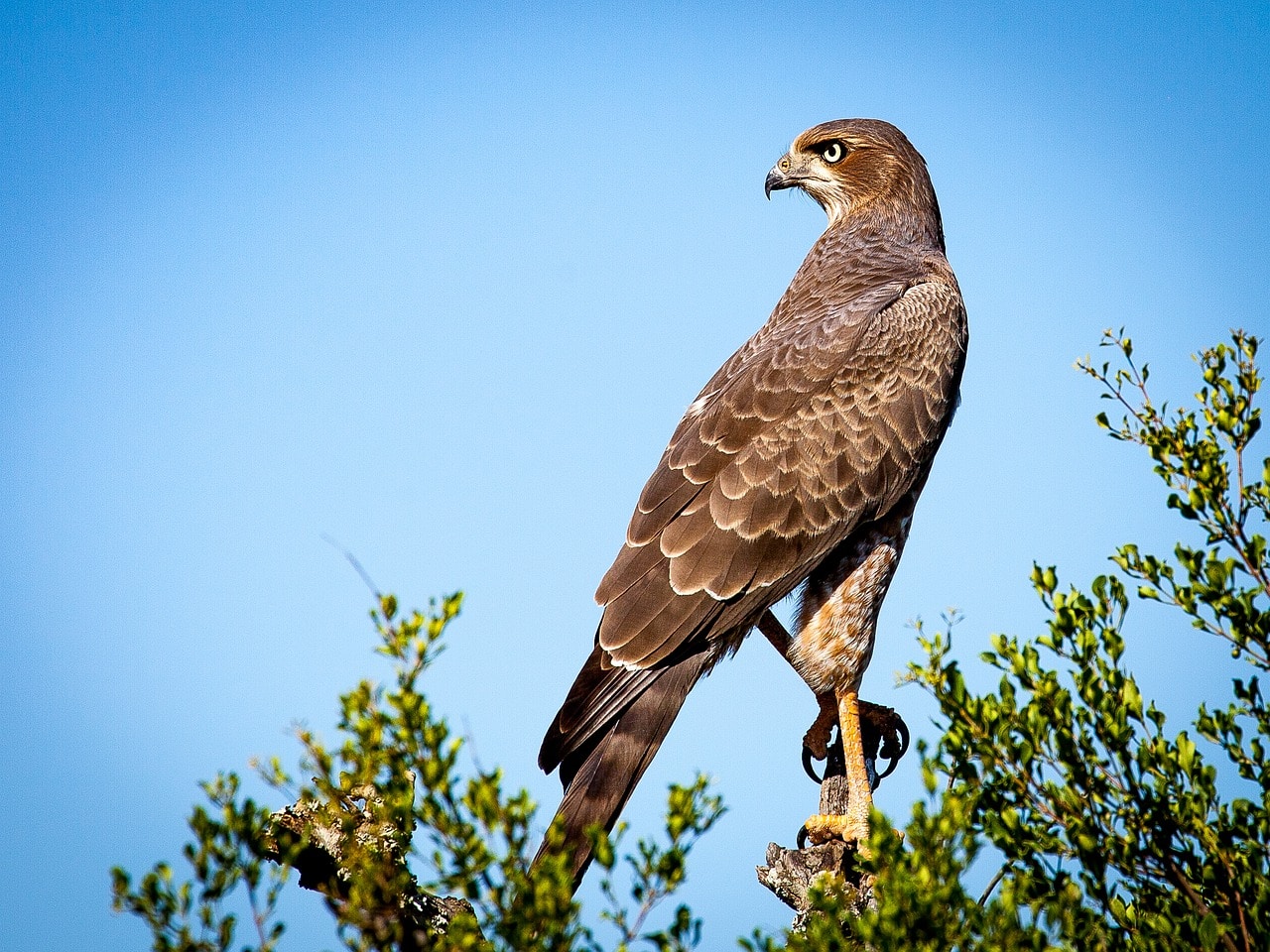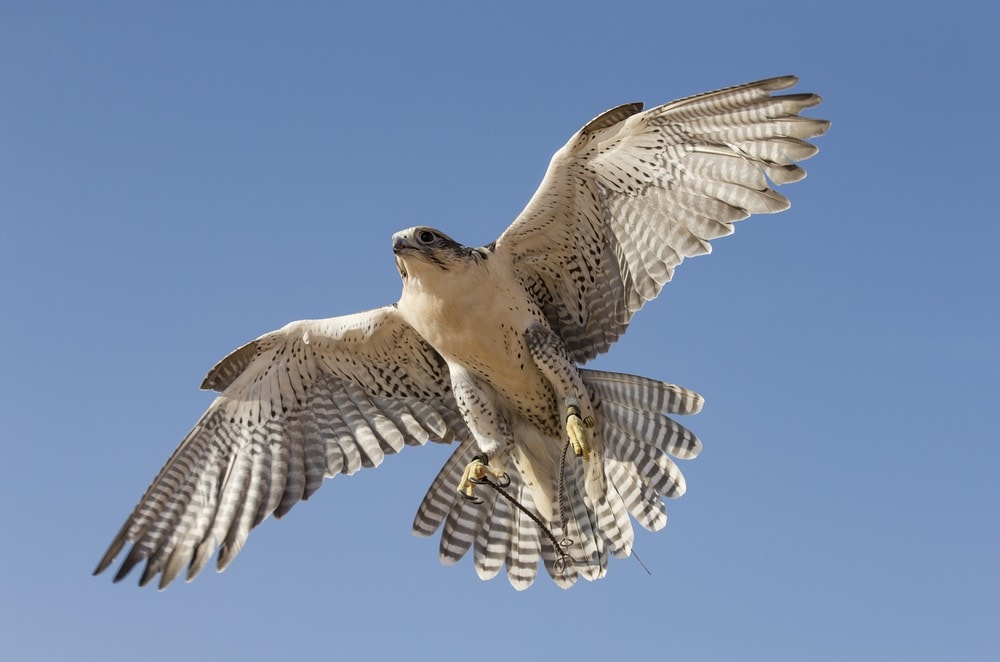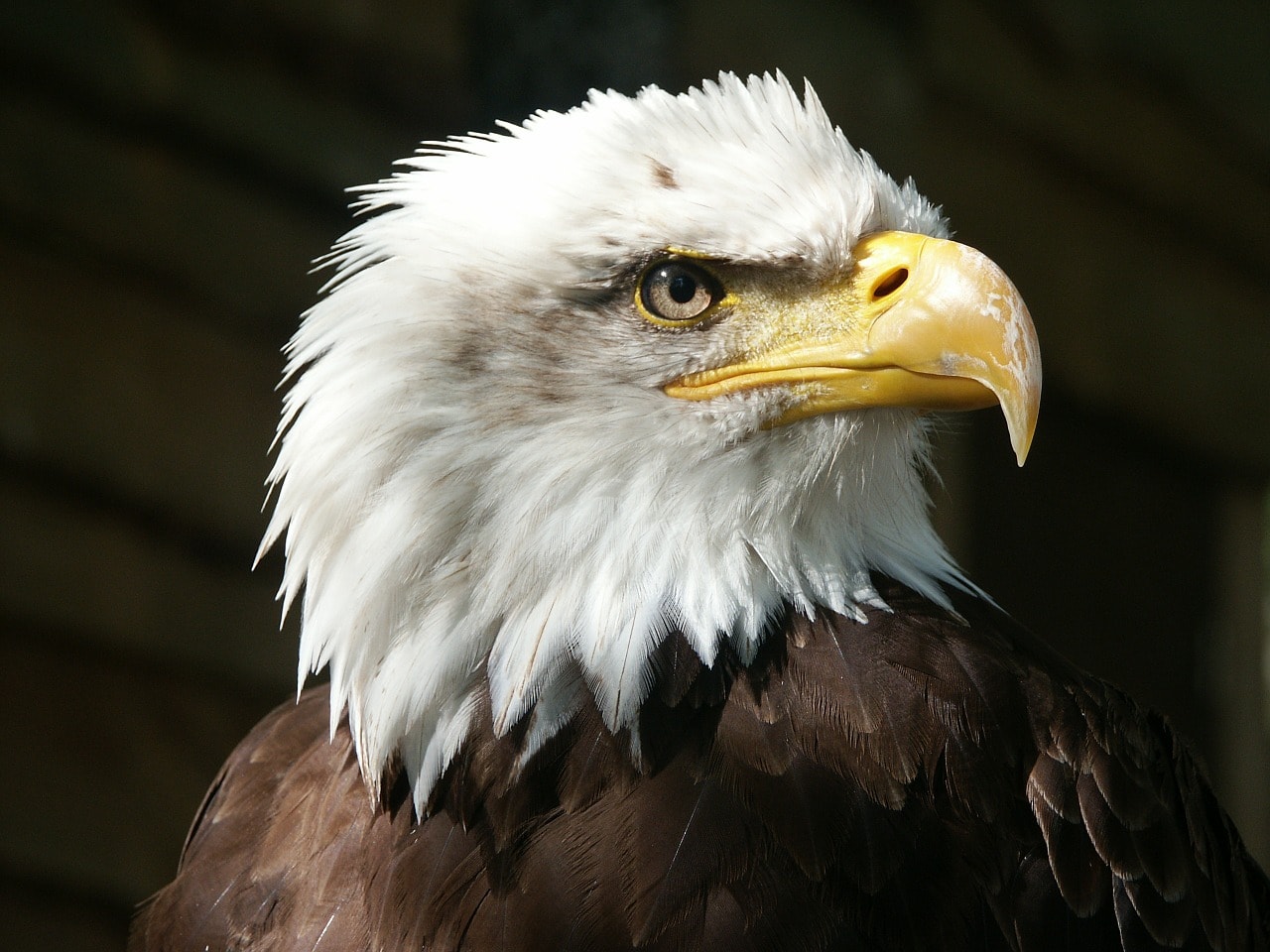Falcon vs. Eagle: What’s the Difference? (With Pictures)
Last Updated on

Both falcons and eagles share a common ancestry that only goes as far back to the fact that they are birds. While scientists were once grouped in the same order, DNA analysis revealed a different picture, splitting the two into two groups, Falconiformes and Accipitriformes, respectively. That fact alone speaks to the variations between the two.
While scientists have divided them, falcons and eagles have several similarities—and stark differences. Both are raptors or birds of prey. They have comparable beaks and claws. However, the analysis also revealed that falcons are genetically closer to parrots while eagles are more alike owls. Falcons as a group are diverse in size and, thus, ecological niches.
On the other hand, eagles are more alike since there are only two common species in the United States, with two accidental ones seen in the country occasionally. Our guide will give you an appreciation of how each group of species fits into the ecosystem and food web.

Visual Differences Between Falcons and Eagles

At a Glance – Falcon vs Eagle
- Average height (adult): 26–43 inches
- Average weight (adult): 5–15 pounds
- Wingspan: 71–91 inches
- Lifespan: Up to 40 years, longer in captivity
- Activity pattern: Diurnal
- Trainability: Intelligent
- Average height (adult): 9–25 inches
- Average weight (adult): 8–74 ounces
- Wingspan: 20–48 inches
- Lifespan: 5–6.4 years, longer in captivity
- Activity pattern: Diurnal
- Trainability: Intelligent
Falcon Overview

As you’ve seen from the At a Glance section, there is a broad range of falcon sizes. That means you’ll also see a wide spectrum of niches, habitats, and diets among these species. They belong to the Falconidae family, of which there are 60 species, including the Crested Caracara. There are six resident species and two accidentals, excluding the Crested Caracara.
All species have a similar body form, with a long, narrow tail, usually but not always banded. Some, such as the American Kestrel, are sexually dimorphic, i.e., the sexes have different color patterns. Others, such as the Gyrfalcon, have more than one color type. They all have parrot-like beaks with a sharp, hooked point. You’ll see many similarities between the species that sometimes make IDing them difficult.
Habitat and Range
The American Kestrel has the largest range of the falcons, covering the entire lower 48 states, most of Canada, Alaska, and down into Central America. The Gyrfalcon has the smallest homeland. It prefers the Arctic barrens, mountains, and seacoasts of North America. You’re most likely to see one in Montana, Idaho, or northern Minnesota.
Many species are elusive, typically of raptors. However, the American Kestrel is a notable exception. You’re as likely tosee this bird in farm country as you are in cities. Likewise, it isn’t unusual for the Peregrine Falcon to build nests on skyscrapers.
Some have more well-defined niches. For example, the Merlin lives in conifer woodlands and marshes. The Prairie Falcon is aptly named for its habitat preference.

Behavior
A defining characteristic of falcons is their tremendous speeds, thanks to their pointy wings and long tails. They also have excellent maneuverability to take prey on the wing. The top speed ever recorded was the 242 mph-dive by a Peregrine Falcon.
Like many raptor species, falcons are primarily solitary, only occurring in groups during migration. Hawk Ridge in Duluth, Minnesota, stands out like a funnel for migrating birds because of its geographical location providing a safe over-land flight. Birdwatchers have recorded tens of thousands of raptors during the fall, including many rare or accidental species.
Prey Species
You can get a clue to what many falcons eat—or at least their prey’s size—by the monikers people give these birds. For example, you may hear an American Kestrel called a sparrow hawk or a Peregrine Falcon, a duck hawk. Many species will take smaller birds because of the advantage that their fast speeds give them on the wing.
Most falcons are opportunistic feeders. The American Kestrel takes a wide variety of foodstuffs, from grasshoppers to rodents to reptiles. Gyrfalcons hunt upland game species, such as the Willow Ptarmigan. They may also capture smaller owls and falcons, as well as the occasional rabbit or Arctic Fox. Falcons rely on stealth with an aerial dive to swoop down on their prey.
- Related Read: Male Kestrel vs Female Kestrel

Migration
Falcons typically migrate, although some are year-round residents if food is readily available. Many prey species remain active during the winter, giving the raptors a reason to stay. Another factor affecting falcons and all wildlife is climate change. A warming planet has shifted typical ranges of raptors to follow their prey species. The predators that occupy a narrow niche are most at risk.
Conservation Status
The conservation status of falcons varies with the species. The International Union for Conservation of Nature and Natural Resources (IUCN) has classified most of these birds as species of least concern, with stable populations. That even includes the once-threatened Peregrine Falcon. The Prairie Falcon is the one exception, with its numbers increasing.
The other different scenario is the Aplomado Falcon. The population of these birds in Central and South America are decreasing. However, the United States is actively reintroducing these raptors and increasing its numbers here.
Another significant factor was the 1972 ban on pesticides, enacted by the US Environmental Protection Agency (EPA). Many other raptor populations have rebounded with the removal of this pesticide, including eagles.

Relationship with Humans
The relationship humans have with the falcon rests with songbird predation. An individual who wants to feed birds will soon find that a falcon or other raptor has taken up residence nearby. However, the effects are likely not significant since falcons aren’t always successful when they go hunting. The greater threats that humans pose are habitat degradation, encroachment, and climate change.
- See also: Are Wind Turbines a Threat to Birds?
Eagle Overview

There are two resident species, the Bald Eagle and the Golden Eagle. The Stellar’s Sea Eagle and White-tailed Eagle are accidentals, typically seen in Alaska and on the Aleutian Islands. These species are part of the Accipitridae family of the order Accipitriformes. Other related species include hawks and accipiters.
All are birds of prey but have different habitats and, thus, diets. The eagles are similar in size. They have a sharp, hooked beak, which is considerably larger than those of falcons. Their claws or talons are bigger, too. The Bald Eagle has bare legs, whereas the Golden Eagle has feathers on them. It’s a reflection of the climates of the areas they inhabit.
Habitat and Range
The eagles’ habitats differ, with little overlap. The Bald Eagle lives near water, whether it’s a shoreline of a lake, stream, or other body of water. Large deciduous or coniferous trees are another must-have for perching or if just to hold up their massive nests. They typically have a diameter of 6 feet, with some over 10 feet or more.
Bald Eagles return to the same nesting area each year. They’ll add more material to the existing structure. Mature trees are necessary so that they can build them at heights over 50 feet or more. That gives the birds the security they need, which makes them less accessible to humans and other predators.
On the other hand, Golden Eagles are birds of the open landscape. You’ll see them in the foothills and plains of the American West. They also inhabit mountainous areas, representing the one habitat type where both species may occupy.
Bald Eagles live all across the lower 48 states into Canada. They often stay near open water in the winter, making them year-round residents in some places. Golden Eagles primarily live west of the Mississippi River into Canada. Sightings in the Upper Midwest aren’t unusual during fall migration.

Behavior
These birds are often solitary, except during migration when they will group together at staging areas. Both species are fiercely territorial during the breeding season. Both parents participate in nest-building and rearing the young. They are solitary, monogamous nesters.
Neither species is particularly vocal. The eagles’ calls are nothing like what TV and film producers will have you believe. More likely, you’re going to hear a Red-tailed Hawk screaming than an eagle. Golden Eagle pairs often hunt together, with one bird doing the chasing and the other dispatching the prey.
Despite their large size, Golden Eagles are surprisingly fast, reaching speeds up to 200 mph. Its large size comes in handy when taking the prey back to its nest. These birds can fly, carrying up to 8 lbs. Like the Bald Eagle, it is a monogamous, solitary nester.
Related Read: Eagle vs Hawk: What’s the Difference? (With Pictures)
Prey Species
The Bald Eagle is an opportunist. It will readily take food from other birds or mammals. Its primary diet is fish of all sizes. It may even feed on carrion and roadkill. Unfortunately, the latter comes at a price, with many birds killed by vehicles. The Bald Eagle may hunt other wildlife, such as rabbits and even turtles.
On the other hand, the Golden Eagle’s preferred prey is mammals of all sizes. It will go after rabbits and hares. However, it can also take down larger animals, such as deer. Some people in other countries will even train them to hunt for them, going after prey even larger animals. Both species rely on a surprise attack to swoop down on their victims.

Migration
The Bald Eagle will migrate from the northern reaches of its habitat, following open water and other migrants. Raptors from southern regions are often year-round residents. These birds also occur near salmon spawning areas where they face competition from more formidable predators, like Grizzly Bears.
The Golden Eagle is a worldwide resident with significant populations in Europe and Asia. Many birds don’t migrate and remain on their breeding range year-round. Prey availability is the deciding factor. Therefore, a lot depends on the activity of these species during the winter months.
Conservation Status
The Bald Eagle and Golden Eagle have benefited from the DDT ban, which affected reproduction by weakening the birds’ eggshells. Their numbers have increased in the last 40 years, along with other raptors faced with similar challenges. Their populations are now stable, at least in the United States.
Relationship with Humans

The Bald Eagle has an edge with its relationship with humans, being the national symbol of the United States since 1782. That has endeared this bird to everyone, birdwatcher or not. Conflicts with humans occur when eagles take pets, which isn’t a rare occurrence for either species, unfortunately.
Other issues have arisen with accidental deaths with birds flying into wind turbines or large-scale solar power plants. These birds are not typically tolerant of people unless feeding on open water. Their innate leeriness has helped protect them from conflict.

Final Thoughts
Both the Bald Eagle and the Golden Eagle are birds worthy of respect. They play vital roles in the ecosystem as the top avian predators. While they have recovered, these birds and wildlife face an even more significant threat with climate change. History has shown us that conservation measures work. Hopefully, many generations to come can admire these magnificent birds.
Featured image credit: (L) Ralph, Pixabay | (R) steve felberg, Pixabay
Table of Contents
About the Author Robert Sparks
Robert’s obsession with all things optical started early in life, when his optician father would bring home prototypes for Robert to play with. Nowadays, Robert is dedicated to helping others find the right optics for their needs. His hobbies include astronomy, astrophysics, and model building. Originally from Newark, NJ, he resides in Santa Fe, New Mexico, where the nighttime skies are filled with glittering stars.
Related Articles:
Monocular vs Telescope: Differences Explained (With Pictures)
How to Clean a Refractor Telescope: Step-by-Step Guide
How to Clean a Telescope Eyepiece: Step-by-Step Guide
How to Clean a Rifle Scope: 8 Expert Tips
What Is a Monocular Used For? 8 Common Functions
How to Clean a Telescope Mirror: 8 Expert Tips
Brightfield vs Phase Contrast Microscopy: The Differences Explained
SkyCamHD Drone Review: Pros, Cons, FAQ, & Verdict

